|
The great white shark is without doubt one of the most
fascinating and mysterious fishes of the sea.. When a dorsal fin
escapes from the surface of the water, the thought goes to this stately
animal and conflicting feelings of attraction and terror born in the
human mind.
The white shark in fact has always catalyzed man attention,
representing one of the greatest raiders of which today science
still ignores many aspects and behaviors.
Its movements and migrations are not known, for example the complexity
of the social relationships with exemplary of the same kind, the
abilities of learning and adaptation from past experiences..
Never have been filmed or photographed exemplary in phase of coupling
and nothing of certain is known respect to the period and the preferred
areas for the reproduction. It remains also a mystery the first years of
life of a white shark, its moves, the strategies of defence by other
greater raiders, the rhythms of growth..
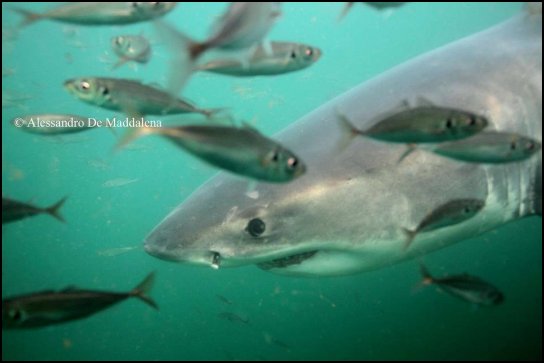
White shark
(Carcharodon
carcharias) and the particular
teeth
The enormous interest toward this animal has made
however to multiply, especially in the last 15 years, the countries of
study and search, and some aspects of the biology of this shark have
been clarified and surely brought to the light of the scientific
community with amazing results:
1) Carcharodon carcharias is the only shark that brings the head out
of the water to check better what it surrounds him and it uses therefore
its acute sight also through the aerial environment.
This animal in fact can count on a good visual ability and it makes
great trust on this sense. Not by chance, in the moment of the attack to
a prey, the white shark protects his eye upsetting back them and he use
his "sixth sense", that allows him to also individualize a prey without
seeing her perceiving her elettro-magnetic field.
(Note 1 - Ampullae Lorenzinii)
2) the white shark can sink him thin to arrive to
around 1200 ms of depth showing a great adaptability to the variations
of pressure, temperature and brightness of the environment in which he
swims.
To oppose the variations of temperature of the oceanic waters to the
various depths the white shark has developed a mechanism of heat maintenance that allows him to have a bodily temperature of 4 - 5 C° to
that of the water that surrounds him and up to 10 C° as it regards the
most inside musculature. This mechanism, the so-called "rete
mirabilis", is common to all the components of the order Lamniformes, to
which the white shark belongs. Further to a best adaptation to the
temperatures of the external environment, the shark draws from the
rete mirabilis great benefit as regards the times of digestion of the
preys, that result faster immediately making available great quantity of
energy. (Note 2 - Rete mirabilis)
With a temperature almost constant the white shark is able of mighty
releases, to sustain elevated cruising speeds, and even of resounding
jumps out of the water, when the attack to one prey of his is realized
upward by the lower part.
3) this animal can live since 30 a 40 years. The small ones to the birth
have a length of around 1,20 ms, their teeth are endowed with small side
cusp and those of the inferior jaw are smooth rather than serrated.
(Note 3 - white shark teeth)
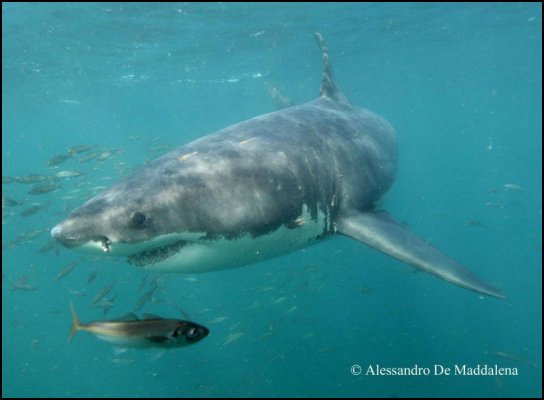
White shark
(Carcharodon
carcharias)
The behavior of an animal is often the only
indicator that the Science has to understand its intellectual abilities.
To study the white shark in his natural environment is very difficult
but a series of repeated strategies have let to the biologists, that
have filmed them and analyzed, the following conclusions on the
intellectual abilities of this great raider:
- the white shark is able of to manifest curiosity, that expresses with
the careful exploration of what meets;
- the white shark possesses the ability "to investigate" new objects in
systematic way, always maintaining a cautious behavior;
- he can learn to recognize objects not grocerieses using the memory of
explorations done in past;
- it has the sense of the ownership and he can defend his sources of
food in calculated way, also not violent; (es: during an attack to a
surfer, in African waters, a white shark is repeatedly set among the
body of the victim and a small raft that tried to recover the victim,
preventing the contact of it and therefore the salvation)
- the white shark finally seems to have the ability to cooperate
together to other samples of his same kind to optimize the predatory
effectiveness; (es: in South Africa numerous white sharks would have
been filmed during the attempt to move together the carcass of a whale
in deeper waters)
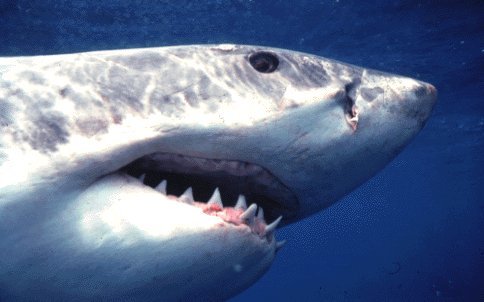
White shark
(Carcharodon
carcharias)
In base to these affirmations the white shark (Carcharodon
carcharias) can be defined an intelligent animal, that possesses the
ability to explore, to remember, to defend, all behaviors contemplated
to an optimal survival and accordingly to a reproductive success,
essential for the pursuance of the kind.
Predatory strategies and relations with the
man: when a potential prey is identified by the white shark it
begins the approach and the investigation.
In this phase the raider realizes what it is found before decreasing
more and more the distance between the thin object and him to reach
brief contacts, small hits with the nose and only sometimes immediate
bites, to appraise the edibility of the possible prey.
If the "results" of his investigation are positive the attack happens,
almost always from the lower part upward.. In this way the white shark
makes him almost invisible, up to the last instant, in how much the
bluish coloration of its back camouflages him with the color of the sea.
The prey finds stopped the opposite direction to that of the attack,
that is the surface, and almost inevitably is overwhelmed and there is
the bite, without way out..
Very often the speed of the attack and the emitted energy are so high
that the body of the shark escape in part out of the water.
Immediately after the bite, the prey is momentarily abandoned, to avoid
damages from a possible struggle with a dying animal, and the white
shark remains to a certain distance, waiting the death arrivals..
After a brief period of time the raider returns on the place of the
attack and devours its prey by now dead or without more strengths to
oppose resistance..
As it regards the relationships with the man the white shark it surely
results to be very dangerous even if the man doesn't reenter among his
usual preys.
The 80% of the attacks not provoked to the man (Note 4
- provoked attacks and not) are concluded after the first bite, when
probably the raider realized that the prey was not of his pleasure..
An only bite of the white shark is able however to provoke damages of
serious entity, because of the strength and of the dimensions of this
animal, and to bring equally to the death, especially in absence of
immediate paramedics..
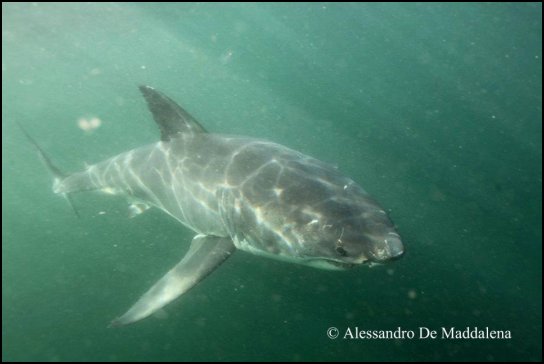
White shark
(Carcharodon
carcharias)
White shark in captivity: the man has never
succeeded in maintaining and therefore to study better a white shark in
captivity, at least up to the year 2003..
It is important to understand that the study in captivity of an animal,
whose presence in the waters of the world is drastically decreased, can
serve to acquire greater awareness on the necessity of protection that
it requires from the man. Examining its behaviors in captivity in fact
the man try to fill those biological and ecological gaps that concern
this shark and at the same time also the exposure to the public can
contribute to cancel so many common places on the so-called one "men's
eater"..
In June 2003 for the first time the Monterey Bay Aquarium in Monterey,
California, has succeeded in maintaining in captivity a white shark for
10 days.
In September 2004 a female, captured for mistake by professional
fishermen, is given to the aquarium and for 198 days this white shark
perfectly suits her for the life in captivity and she is exposed to the
public with great success.
In March 2005 this white shark, not to excessively prolong her
permanence in captivity and to protect her from excessive stress, is
released in open sea and studied for 30 days, aquiring in this way an
important massive structure of data and biological information.
On August 31 st 2006 the Monterey Bay Aquarium holds in captivity
another sample, which shows to have suited well for the new situation,
normally feeding himself and increasing of weight and length.
On January 16 th 2007, after 137 days inside the aquarium, this shark is
released, and thanks to the application of a satellitar tag
(electronic signaller) that April 16 th 2007 is
detached, all of its movements have been reconstructed in open sea
within these three months. The shark has swum up to the south point in
the Baja California, crossing more than 1000 km and reaching depth
superior to the 300 m.
In the month of August 2007 a
white shark is accidentally captured by the net of fishermen, in
California, and he is brought to the Monterey Bay Aquarium, where the
animal grows of weight and length for 162 days to be released in liberty
in February 2008. The last white shark that the Monterey Bay Aquarium
has taken care has been in summer 2011: the animal as his
predecessors, is regularly fed growing of dimensions and returned in
liberty.
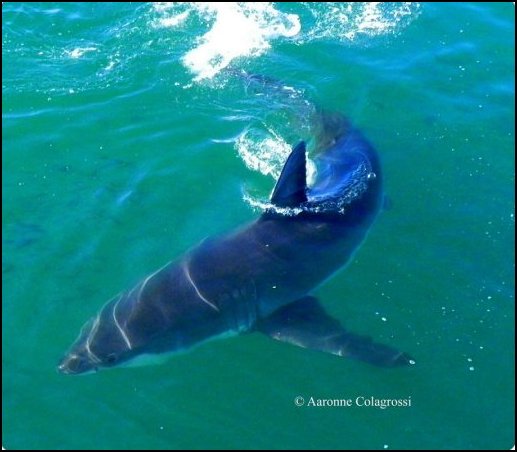
White shark
(Carcharodon
carcharias)
White shark in nature:
currently are two the principal destinations in the world that can be
reached to observe the great white shark in nature: the region of
Gansbaai and particularly the island of Dyer in South Africa and the
area of Dangerous Reef, offshore the peninsula Eyre in southern
Australia.
1) Gansbaai is a small
village of fishermen that is found to about two hours with car by the
more note Cape Town (180 km of distance).
The area is enough calm and what can offer is the beauty of its nature,
and also the not scuba tourist can appreciate with long walks along the
coasts.
The white sharks can be seen in particular way near the island of Dyer,
primarily sandy and distant few km from Gansbaai.
In these zones there are, in fact, numerous seal colonies, together with
their pups, appetizing preys for this great raider of the seas.
As it regards the immersions, there are different centers that organize
exits in sea with the metallic cage to see the white sharks, also
recommend to the beginners, with the desire however to live strong
emotions.
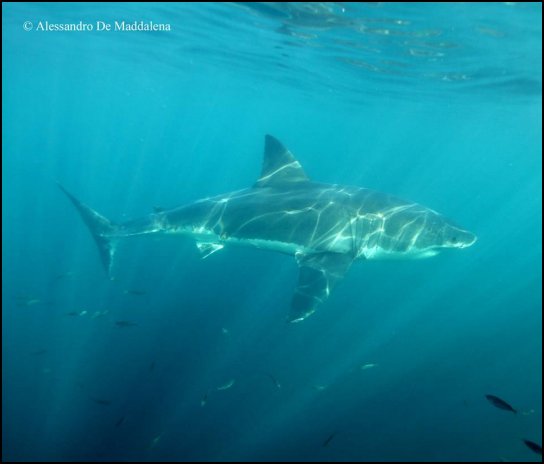
White shark
(Carcharodon
carcharias)
2) Dangerous Reef owes
first of all the name not to the presence of the white sharks, but to
the dangerousness of the zone for the navigations, near the Gulf of
Spencer. This bluff is found offshore the peninsula Eyre, in southern
Australia, also this zone populated from numerous seals, sea lions and
therefore also white sharks.
In this zone and in the near islets can be observed more than 12000 sea
lions, the greatest colony in Australia. Also here the not scuba tourist
can appreciate the beauty of the nature, the tones of the ocean and the
beaches, both rocky and sandy, also participating in the exits of the
organizations that transport the scuba divers in the various zones of
immersion.
Also the emerged earth in fact proposes his beauties, without
forgetting, as already mentioned, the numerous seals and sea lions
present in every islet of the zone.
As it finally regards the immersions, also here they are realized with
the aid of the metallic cages of protection, in surface for the
beginners and on the fund for more experts.
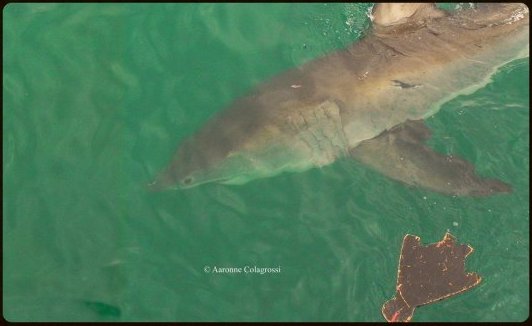
White shark
(Carcharodon
carcharias)
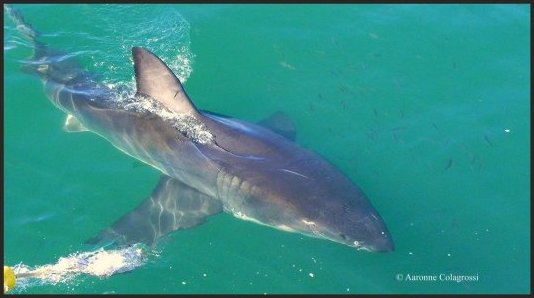
White shark
(Carcharodon
carcharias)
Biological card of the white shark (Carcharodon
carcharias):
WHITE SHARK
Carcharodon carcharias
LINNEO, 1758
Order: Lamniformes
Family: Lamnidae
Middle dimensions: 350-460 cms.
Maximum dimensions: it overcomes the 700 cms.
The greatest sample captured by the man was a female of 7,14 meters.
The white shark is drastically decreased of number in all the seas of
the world and this has pushed many countries to declare him/ protected
kind.
Description: shark of great dimensions, thick, with the pointed face.
The mouth is ample the round and black eyes. The dorsal fins are two,
her before averages dimensions, the dwarfish second. The pectoral fins
are wide and falcades, while the caudal fin is symmetrical and to
crescent. The white shark can reach the 60 km. also thanks to the
possibility to maintain his muscles to a temperature of 10°C superior to
that of the water that surrounds him.
Distribution: in all the moderate and sub-tropical seas of the world,
present in the Mediterranean sea. It is hypothesized the existence of a
reproductive area between Sicily and Tunisia.
Coloration: grey-bluish back with clean passage to the white of the
abdomen. Stung ax in the ventral part of the pectoral fins.
Reproduction: probably ovoviviparous (viviparous without placenta),
unknown period of pregnancy.
Commercial value: object of sporting and commercial fishing for the
liver, the skin, the fins, the carcass, the teeth and the jaws.
Teeth: triangular, astute, strongly serrated to the borders. The teeth
of the superior jaws (from 23 to 28) and inferior (from 21 to 25) are
very similar.
The scientific name can be translated in "dangerous shark for the man
from the rough teeth". The small ones to the birth have teeth with side
cusp and those of the inferior jaw are smooth.
Diet: sharks and races, bony fishes (tunas and fish-sword), molluscs,
shellfishes, cefalopods, sea turtle, mammalian sea and carcasses of
whales.
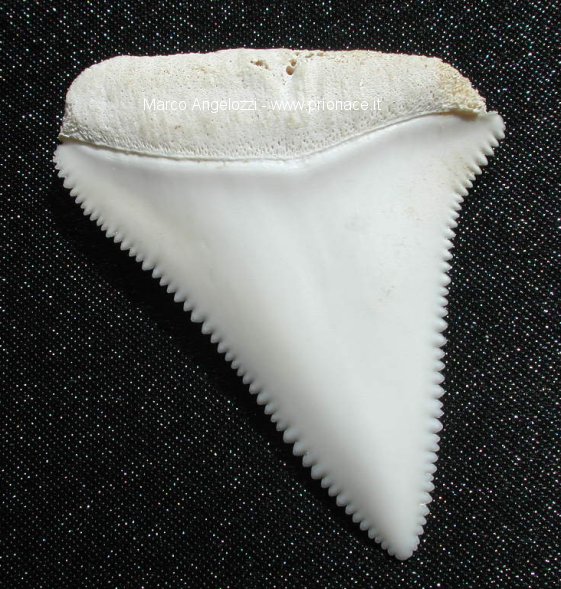
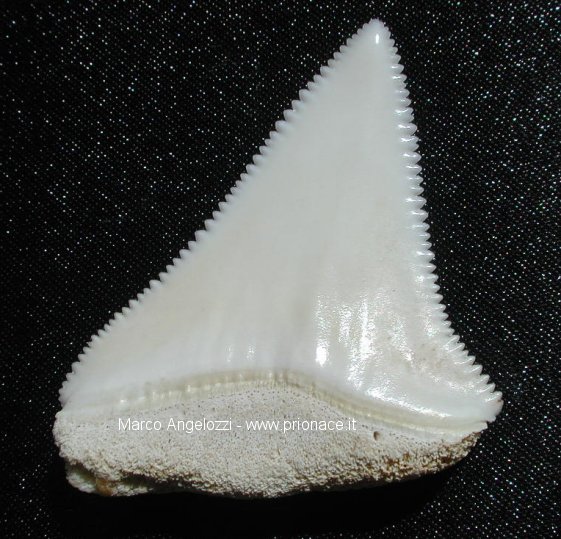
Teeth of white shark
(Carcharodon
carcharias)
NOTE 1: The Ampullae of Lorenzinii
are of the organs that take contact with the outside through small and
numerous holes, present especially in the region of the head, full of a
gelatinous conductor substance, in communication with nervous
terminations. In this way the shark has the ability to perceive the
electric fields produced by the animals (therefore to also individualize
preys under the sand) and probably to recognize his own position in
comparison to the earth magnetic field.
NOTE
2: The rete mirabilis is a whole of capillary that have the
function of heat change, it is connected to muscular bands very
develop, next to the vertebral column. Through the exchanges of heat of
the admirable net the inside musculature of the white shark and the
brain remain more warm temperatures of those of the surrounding water.
NOTE
3: The white shark teeth are unmistakable for its unique
characteristics. They are great, triangular, astute, strongly serrated
to the borders. The teeth of the jaws superior and inferior they are
very similar.
NOTE
4: An attack to the man from a shark is defined not provoked
when the animal is found in his natural environment and he has not
suffered anybody stimulus or direct provocation from the man.
Bibliography: "Sharks
& Rays, Elasmobranch Guide Of The World". Ralf M. Hennemann, "Sharks of
the world", Leonard Compagno, M. Dando, S. Fowler, "The white shark",
Jean Michel Cousteau, Mose Richards, "Sharks", Jeremy Stafford-Deitsch.
Marco Angelozzi -
www.prionace.it
E' assolutamente
vietata la riproduzione, anche parziale, del testo
e delle fotografie di questo articolo, senza il consenso degli autori.
|
|
![]()